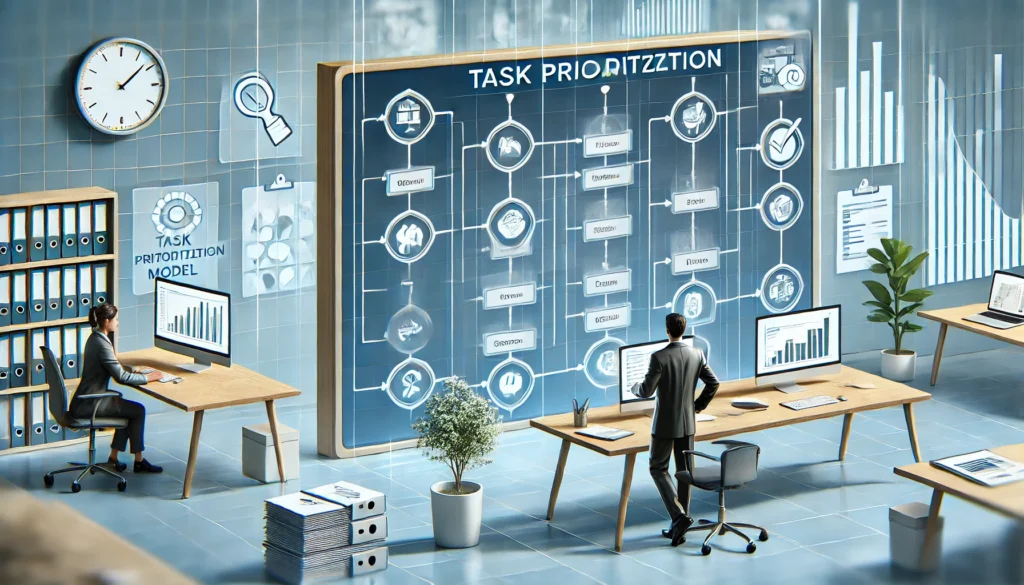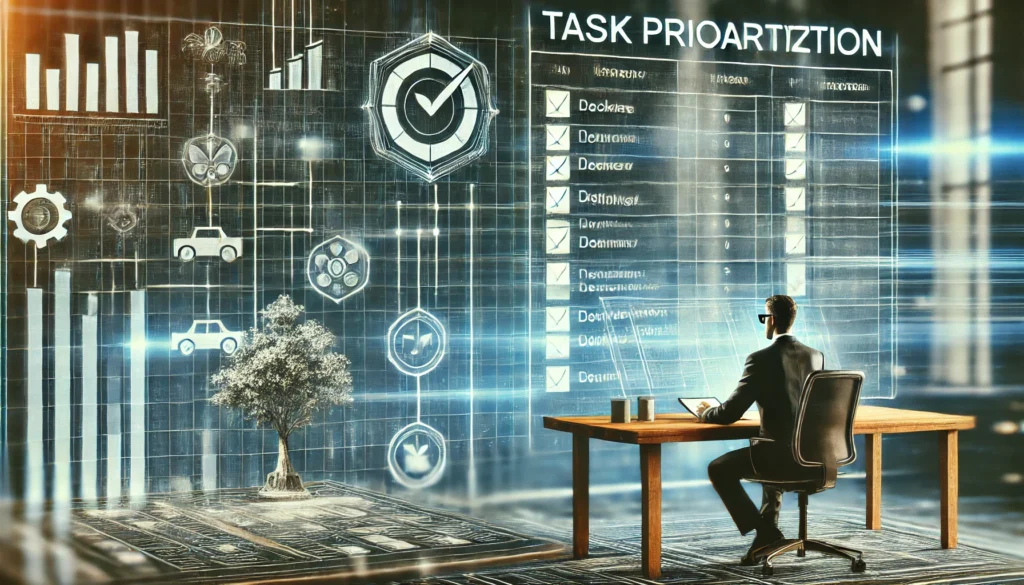In the fast-paced world we inhabit, mastering the art of task prioritization is essential to enhance productivity and achieve work-life balance. Task prioritization involves deciding which tasks are most important and focusing on them, enabling you to manage your workload efficiently. This article explores various models and strategies for prioritizing tasks effectively, which can be applied to personal and professional settings alike.
You may also like: Overcoming Distractions: Focus at Work
Understanding Task Prioritization
Task prioritization is the process of organizing tasks in order of importance and urgency. It involves assessing your workload and determining the sequence in which tasks should be addressed. Effective prioritization can help you allocate time and resources more efficiently, leading to improved productivity and reduced stress.
The Core Components of Task Prioritization
At its core, task prioritization is about distinguishing between what needs immediate attention and what can wait. Understanding the nature of each task is crucial. Some tasks have deadlines that must be met, while others are more flexible. By identifying these components, you can tailor your approach to fit the specific demands of your workload.
Key Benefits of Task Prioritization
Prioritizing tasks comes with numerous benefits. Firstly, it allows you to focus on high-impact activities that align with your goals. Secondly, it reduces decision fatigue, as you have a clear plan of action. Lastly, prioritization can lead to less stress, as you gain a sense of control over your responsibilities.
Common Challenges in Task Prioritization
Despite its benefits, task prioritization can be challenging. One common obstacle is the temptation to tackle easy tasks first, leaving more demanding tasks for later. Another issue is the constant influx of new tasks, which can disrupt your plans. Recognizing these challenges is the first step towards overcoming them.
The Importance of Prioritization in Time Management
Prioritization is a cornerstone of effective time management. By identifying and focusing on high-priority tasks, you can ensure that your efforts align with your goals and objectives. This approach minimizes the risk of becoming overwhelmed by less important tasks and allows you to dedicate your energy to what truly matters.
Aligning Prioritization with Personal Goals
To effectively prioritize, it’s essential to align your tasks with your long-term goals. This means understanding what you want to achieve in both your personal and professional life. By doing so, you can ensure that your daily activities contribute meaningfully to your larger objectives.
The Role of Flexibility in Task Prioritization
While having a prioritized list is crucial, flexibility is equally important. Life is unpredictable, and new tasks can emerge unexpectedly. Being adaptable allows you to rearrange priorities without losing sight of your main goals. This flexibility is key to maintaining productivity in dynamic environments.
Overcoming Decision Paralysis
Decision paralysis can occur when you’re unsure about which task to prioritize. This often leads to procrastination. To overcome this, it’s helpful to use a structured approach, such as one of the prioritization models we’ll discuss. This structure can provide clarity and direction, making it easier to start your day with confidence.

Models and Techniques for Prioritizing Tasks
There are several models and techniques you can use to prioritize tasks, each with its own strengths and applications. Below, we explore some of the most effective methods for task prioritization.
The Eisenhower Box: Urgent vs. Important
The Eisenhower Box, also known as the Urgent-Important Matrix, is a simple yet powerful tool for prioritizing tasks. It categorizes tasks into four quadrants based on their urgency and importance:
Urgent and Important: Immediate Action Needed
These tasks are critical and require your immediate attention. They often have significant consequences if not completed promptly. By focusing on these tasks first, you can prevent crises and ensure that pressing issues are resolved efficiently.
Important but Not Urgent: Planning for Success
Tasks in this category are crucial for achieving long-term goals but don’t demand immediate action. Scheduling dedicated time for these tasks ensures that you make progress on significant projects without the pressure of urgency. This proactive approach can lead to substantial long-term benefits.
Urgent but Not Important: Delegation Opportunities
These tasks demand quick attention but don’t significantly impact your main objectives. Delegating such tasks can be an effective strategy, allowing you to focus on more important activities. Delegation not only frees up your time but also empowers others to contribute.
Not Urgent and Not Important: The Time Wasters
Tasks that fall into this quadrant add little value to your goals. Identifying and minimizing these activities can significantly increase your efficiency. By eliminating time wasters, you create more space for tasks that truly matter.
The ABCDE Method: Prioritizing with Precision
The ABCDE Method is a straightforward approach to prioritizing tasks by assigning each task a letter based on its importance:
A: Top Priority Tasks
Tasks labeled as ‘A’ are critical and must be addressed immediately. These are often directly tied to your goals and have serious consequences if neglected. By tackling these first, you ensure that your most vital responsibilities are managed effectively.
B: Important but Less Urgent
‘B’ tasks are important but can wait until ‘A’ tasks are completed. They require attention but don’t carry the same urgency. By recognizing these distinctions, you can plan your day without neglecting important activities that aren’t immediately pressing.
C: Desirable but Not Essential
Tasks in the ‘C’ category are nice to have completed but aren’t crucial. These activities can enhance your work or personal life but won’t drastically impact outcomes if delayed. It’s essential to balance these tasks against more pressing responsibilities.
D: Tasks to Delegate
‘D’ tasks are those that can be handed off to others. Delegation is a powerful tool for maximizing productivity, allowing you to focus on tasks that require your expertise. By effectively delegating, you can expand your capacity and drive better results.
E: Eliminate Unnecessary Tasks
‘E’ tasks should be eliminated altogether. These are activities that add no real value and can be cut to streamline your workflow. Removing these tasks reduces clutter and enhances focus on what truly matters.
The Pareto Principle: The 80/20 Rule
The Pareto Principle, or the 80/20 Rule, suggests that 80% of your results come from 20% of your efforts. When applied to task prioritization, this principle encourages you to identify and focus on the tasks that have the most significant impact on your goals. By concentrating on these high-value tasks, you can maximize your productivity and effectiveness.
Identifying Your High-Impact Tasks
To leverage the 80/20 Rule, start by identifying which tasks contribute most to your success. These are often tasks that drive the majority of your results. By pinpointing these activities, you can allocate your time and resources more strategically.
Streamlining Efforts for Maximum Output
Once you’ve identified the high-impact tasks, focus on optimizing how you perform them. This might involve improving skills, investing in better tools, or rethinking your approach. By enhancing these tasks, you can multiply their benefits.
Balancing the Remainder
While focusing on the 20% is crucial, the remaining 80% of tasks still need to be managed. Finding efficient ways to handle these can prevent them from becoming bottlenecks. Consider automation, delegation, or batching similar tasks to maintain balance.

Practical Steps for Effective Task Prioritization
Create a Prioritized To-Do List
Start by listing all the tasks you need to complete. Then, assign priorities to each task using one of the models discussed above. This prioritized to-do list serves as a roadmap for your day, helping you stay focused and organized.
Structuring Your To-Do List
A well-structured to-do list can significantly enhance productivity. Begin by categorizing tasks based on priority levels. This might involve using headings or color-coding for quick reference. Such a structure makes it easier to navigate through your tasks efficiently.
Incorporating Deadlines and Dependencies
Understanding task deadlines and dependencies is essential for effective prioritization. Some tasks may rely on the completion of others, so incorporating these elements into your list ensures a logical flow. This awareness can prevent bottlenecks and ensure timely completion.
Regular Review and Adjustment
Your to-do list should be a dynamic tool that evolves with your workload. Regularly review and adjust it to reflect changes in priorities or the emergence of new tasks. This continuous refinement keeps your list relevant and aligned with your goals.
Assess and Reassess Your Priorities
Task prioritization is not a one-time activity. It requires continuous assessment and adjustment as new tasks arise and circumstances change. Regularly review your priorities to ensure they remain aligned with your goals and objectives.
Establishing a Review Routine
Set aside dedicated time each week to review your tasks and priorities. During this time, assess what was accomplished, what needs more attention, and any new tasks that have emerged. A consistent routine helps maintain clarity and focus.
Adapting to Changing Circumstances
Flexibility is crucial in task prioritization. As circumstances change, be prepared to adapt your priorities accordingly. This might involve shifting focus to new opportunities or challenges that have arisen. Being adaptable ensures continued alignment with your goals.
Learning from Past Prioritization
Reflecting on past prioritization efforts can provide valuable insights. Consider what worked well and what didn’t, and use this knowledge to refine your approach. Continuous learning from experience enhances your ability to prioritize effectively.
Leverage Technology for Task Management
Utilize task management tools and apps to streamline your prioritization process. These tools can help you create digital to-do lists, set reminders, and track progress, making it easier to manage your workload effectively.
Choosing the Right Tools
Not all task management tools are created equal. Research and choose tools that best fit your workflow and preferences. Some tools offer simple to-do lists, while others provide advanced project management features. Selecting the right tool can enhance your efficiency.
Integrating Technology with Your Workflow
Integrating technology into your daily routine can streamline task management. Use apps to sync tasks across devices, set reminders, and collaborate with others. Seamless integration ensures that you stay organized and on track, regardless of where you are.
Utilizing Features for Enhanced Productivity
Explore the features offered by task management tools to maximize productivity. This might include setting deadlines, prioritizing tasks, or automating repetitive activities. Leveraging these features effectively can save time and reduce the risk of overlooking important tasks.

Balancing Work and Well-being
Effective task prioritization not only enhances productivity but also contributes to a healthier work-life balance. By focusing on high-priority tasks, you can free up time for personal pursuits and self-care, reducing stress and improving overall well-being.
The Role of Mindfulness in Task Prioritization
Mindfulness practices, such as meditation and deep breathing, can improve your focus and decision-making abilities, enhancing your task prioritization skills. By cultivating mindfulness, you can approach tasks with clarity and purpose, making more informed choices about where to direct your energy.
Developing a Mindfulness Routine
Integrate mindfulness into your daily routine by setting aside time for practices like meditation or deep breathing exercises. These activities can help clear your mind, improve focus, and reduce stress, setting a positive tone for prioritization.
Mindfulness as a Decision-Making Tool
Mindfulness can enhance your decision-making abilities by promoting a calm and focused mindset. When faced with multiple tasks, a mindful approach allows you to assess priorities objectively, ensuring that your choices align with your goals.
Mindfulness and Stress Reduction
Practicing mindfulness can significantly reduce stress, a common byproduct of juggling numerous tasks. By reducing stress levels, you create a more conducive environment for effective prioritization, ultimately leading to better productivity and well-being.
Achieving Work-Life Harmony
Balancing work and personal life is essential for overall well-being. Effective task prioritization can help achieve this balance by ensuring that both professional responsibilities and personal interests are given appropriate attention.
Setting Boundaries Between Work and Personal Life
Establish clear boundaries between work and personal life to maintain balance. This might involve setting specific work hours, creating a designated workspace, or scheduling time for relaxation and hobbies. Boundaries help prevent work from encroaching on personal time.
Prioritizing Self-Care and Personal Interests
Incorporate self-care and personal interests into your prioritization process. Allocate time for activities that rejuvenate you, such as exercise, hobbies, or spending time with loved ones. Prioritizing self-care enhances well-being and prevents burnout.
Evaluating Work-Life Balance Regularly
Regularly assess your work-life balance to ensure it’s aligned with your values and goals. Adjust your priorities if necessary to address any imbalances. Continuous evaluation helps maintain a healthy equilibrium between professional and personal pursuits.
Conclusion
Task prioritization is an essential skill for anyone seeking to boost productivity and achieve a harmonious balance between work and personal life. By implementing the models and techniques discussed in this article, you can effectively prioritize your tasks, manage your time, and accomplish your goals with greater ease and efficiency. Remember, the key to successful prioritization lies in continuous assessment and adaptation, allowing you to navigate the ever-changing demands of modern life.
Embracing a Growth Mindset
Approach task prioritization with a growth mindset, recognizing that your skills can improve over time. Embrace challenges as opportunities for learning and growth, and remain open to adapting your strategies. This mindset fosters resilience and continuous improvement.
Building a Supportive Environment
Cultivate a supportive environment that encourages effective prioritization. This might involve collaborating with colleagues, seeking feedback, or utilizing resources that facilitate productivity. A supportive environment can enhance your ability to prioritize effectively.
Celebrating Achievements and Progress
Take time to celebrate your achievements and progress in task prioritization. Recognizing your successes, no matter how small, reinforces positive habits and motivates continued effort. Celebrating milestones fosters a sense of accomplishment and encourages sustained productivity.
Further Reading:
The Eisenhower Matrix: How to prioritize your to-do list
9 Prioritization Frameworks + Tools to Help You Use Them
A Practical Guide to Prioritization for Project Managers
Important Note: The information contained in this article is for general informational purposes only, and should not be construed as health or medical advice, nor is it intended to diagnose, prevent, treat, or cure any disease or health condition. Before embarking on any diet, fitness regimen, or program of nutritional supplementation, it is advisable to consult your healthcare professional in order to determine its safety and probable efficacy in terms of your individual state of health.
Regarding Nutritional Supplements Or Other Non-Prescription Health Products: If any nutritional supplements or other non-prescription health products are mentioned in the foregoing article, any claims or statements made about them have not been evaluated by the U.S. Food and Drug Administration, and such nutritional supplements or other health products are not intended to diagnose, treat, cure, or prevent any disease.


